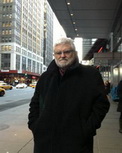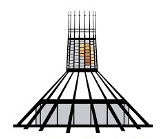 Chris
McDonnell, UK
Chris
McDonnell, UKchristymac733@gmail.com
 Chris
McDonnell, UK
Chris
McDonnell, UK
christymac733@gmail.com
Previous articles by Chris Comments
welcome here
June 20, 2018
A
cathedral for our time
Concrete
and stained glass crown the top of Mount Pleasant in Liverpool, the home
land for the Metropolitan Cathedral of Christ the King. Last month we
marked its opening date, May 14th, 1967, fifty one years ago. Early this
September the Archdiocese will be the focus of 'Adoremus', the National
Eucharistic Congress.
As
a major international port, the significance of the city of Liverpool in
the life of our country is a long story, going back to the infamous days
of slavery. In the 19th century it was the point of arrival for the poor
of Ireland fleeing their country as a consequence of the Great Famine.
With this huge influx, the Catholic population of the city grew
dramatically, for although some used the city for further embarkation to
North America, a significant number stayed and settled in the city. The
co-adjutor Bishop of Liverpool, Alexander Goss, saw the need for a
cathedral and settled on a site in Everton to fulfil his dream.
Pugin
was selected as the architect and by 1856, the Lady Chapel of the new
cathedral had been completed. Financial restraints brought the whole
project to a halt. It wasn't until the 1930s that Edwin Lutyens began work
on his design for a cathedral on a site at the top of Brownlow hill. His
proposed edifice got no further than the crypt when, in 1956, building
ceased.
The
present cathedral, built over Lutyens crypt, was completed in five years
and opened in 1967. The inspirational design, of a circular form round a
central altar, offers a different aspect to the long nave and choir of the
more traditional designs. Following its opening, the design a number of
new parish churches across the country were strongly influenced by
Liverpool.
The
lantern that rises from the conical structure over the high altar is
brilliantly lit with red, blue and yellow glass, the work of the artist
John Piper: not the traditional thin coloured glass set in a tracery of
lead but thick, vibrant chunks of glass set in a concrete lattice, a bold
statement of intent if ever there was one.
Within
the concrete buttresses that rise to support the tower are set small
chapels for prayer and seclusion. Beyond the High altar is the Blessed
Sacrament chapel with its beautiful abstract wall panel in yellow and
white. Of all the artistic decoration in the cathedral, this I treasure
most and for many years a print of that image was pinned to the wall
behind the desk in my office in school. It is quite beautiful.
Along
Hope Street, it is but a short walk to the Anglican cathedral, two centres
of Christian worship connected by a street called hope. They have a
further, less well known link, the sculptor Elisabeth Frink, for two
significant pieces of her work are to be found in the cathedrals.
The
figure of Christ crucified, designed by Frink, hangs over the High altar
in the Metropolitan cathedral, whilst one of her last works, the Welcoming
Christ of Resurrection is positioned over the West entrance to the
Anglican cathedral. Both fine pieces of devotional art, very different in
their expression, the work of a great figurative artist.
There
is a coolness and quiet response to footfall and voice in the circular
space within the concrete cone. Beyond that cone, rising over the entrance
steps from Mount Pleasant is the concrete bell tower, a free standing
structure housing the four great bells of the cathedral.
What
a fine, magnificent statement of faith the whole design represents! It is
a memory of my few years teaching on Merseyside that remains with me.
To
return to this coming September and the Eucharistic Pilgrimage and
Congress in Liverpool. On the Catholic News website there is this summary
of intention.
'The
bishops of England and Wales are holding a National Eucharistic Pilgrimage
and Congress in Liverpool in September 2018.
Eucharistic
Congresses are gatherings of clergy, religious and laity which promote an
awareness of the central place of the Eucharist in the life and mission of
the Church.
The
last International Eucharistic Congress in England was held in 1908 when
permission for a public procession of the Blessed Sacrament was
refused.
Participants
will engage in a series of sessions focusing on different dimensions of
the Eucharist and the daily celebration and adoration of the Blessed
Sacrament'.
This
time of year is often the occasion of First Communion; to conclude, a
brief reflection.
With
bare, open hands we stand in utter stillness
before
the Table of the Lord.
As
once we did then, so still we do now
Christ-caught,
hand-held
with
this shared Eucharistic Bread broken between us
and
a cup to satisfy our thirst.
Later
in the silence of thanksgiving
pause
to share with others this simple, awesome gift.
Be
at one
in
a time
of
prayer.
===============
